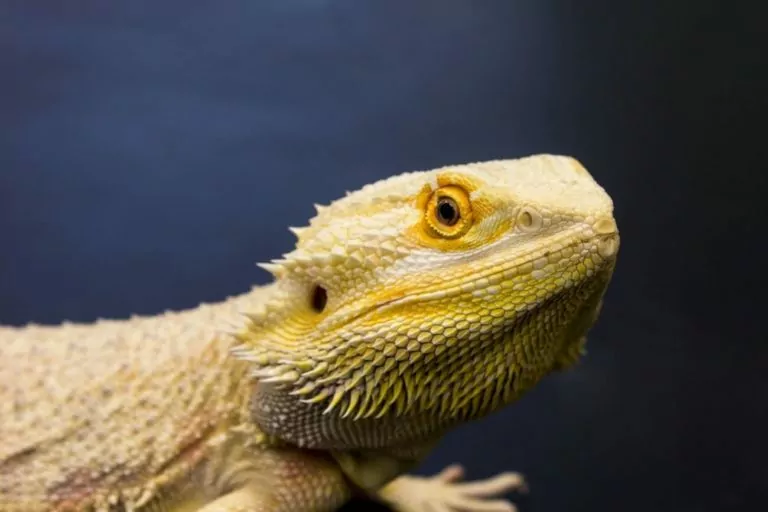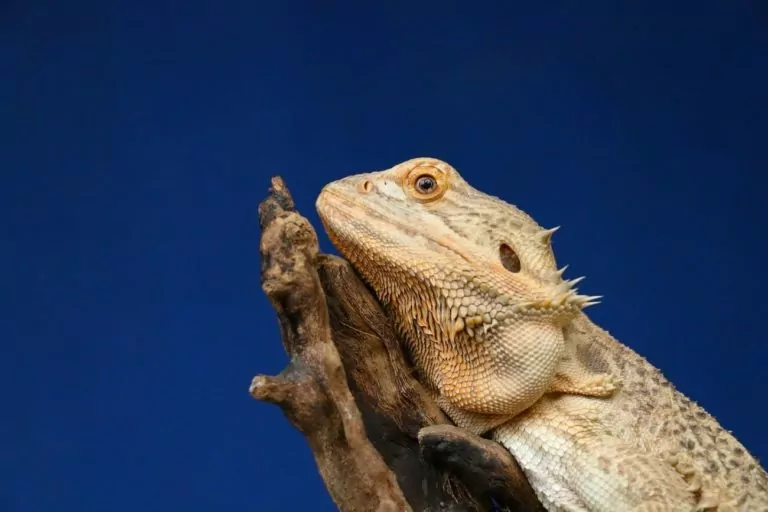Picking between the best types of pet lizards can seem overwhelming at first. There are so many good options out there!
To make things easier, we put together this list of our favorites. Whether you’re a beginner or an expert, there’s something on this list for everyone.
Bearded Dragon
One of the most iconic and best pet lizards to grace the herpetology world, bearded dragons are a joy to raise. These reptiles are quite tame, beginner-friendly and can develop strong relationships with humans. They are always down to play and don’t mind being handled once they develop some trust in their caretakers.
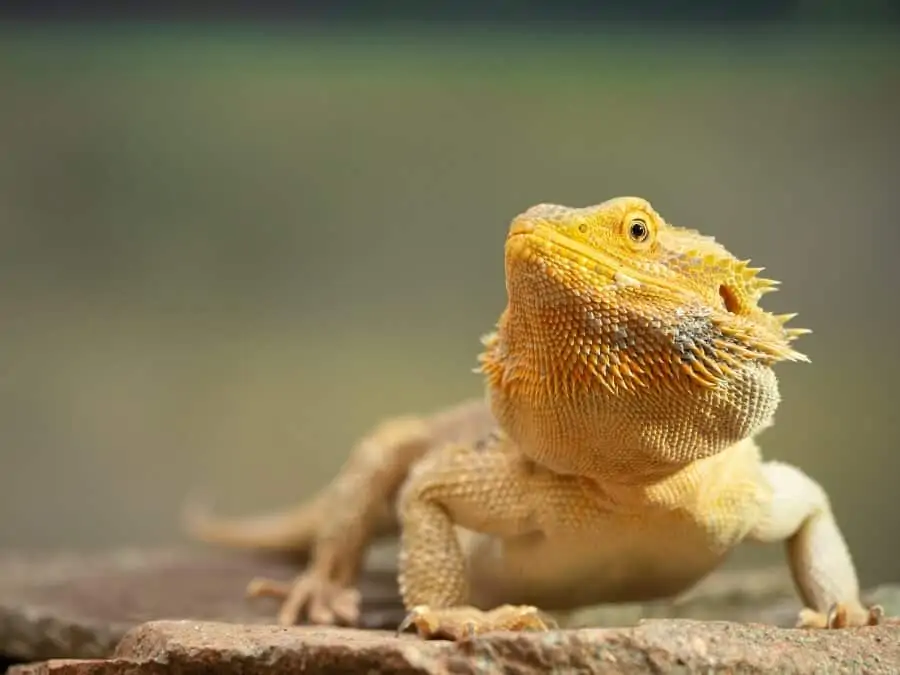
Beardies are endemic to warm environments in Australia. But, they easily adapt to a wide range of habitats. The lizards prefer strong basking lights and plenty of places to lounge around. They also require toys for enrichment and hides for security.
Caring for a bearded dragon isn’t too difficult. In fact, they’re often responsible for sparking interest in new reptile enthusiasts. However, they do require daily attention to ensure that their environment is always safe and healthy.
Red-Eyed Crocodile Skink
The red-eyed crocodile skink is a beautiful type of lizard with a distinct look. It’s aptly named after the red coloration around the eyes. The rest of the lizard’s body is impressive, too. With their triangle-shaped head and keeled scales, they look like miniature prehistoric beasts!
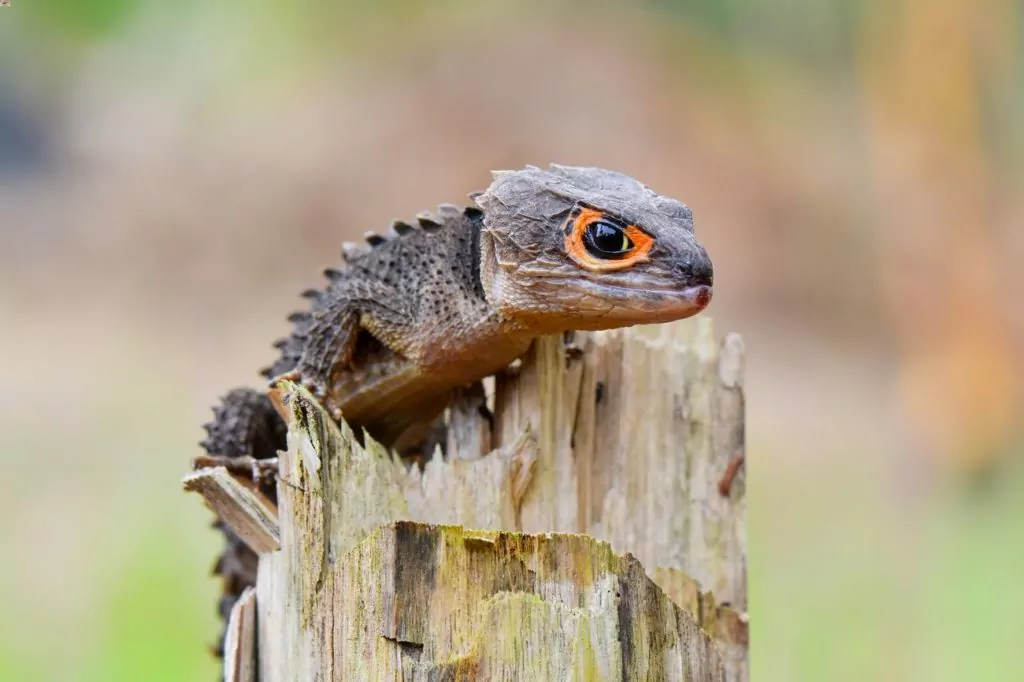
Despite their somewhat intimidating appearance, red-eyed crocodile skinks are very shy. They are a docile reptile that will spend most of its time in hiding. Even once it gets comfortable in its new home, don’t expect to see a ton of activity throughout the day. As a crepuscular species, they reserve activity for dusk and dawn.
Reaching lengths of about seven to nine inches, the red-eyed crocodile skink is very manageable. You don’t need a massive enclosure to house them. However, more ground space is always welcome.
These lizards prefer to live in natural habitats filled with plants and hiding places. A few climbing branches are appreciated. But this species will spend most of its time on the floor of its home.
Green Anole
If you’re looking for a pet lizard that’s easy enough for kids to raise, the green anole is the species for you. Often seen in elementary school classrooms, these lizards are small, peaceful, and non-demanding.
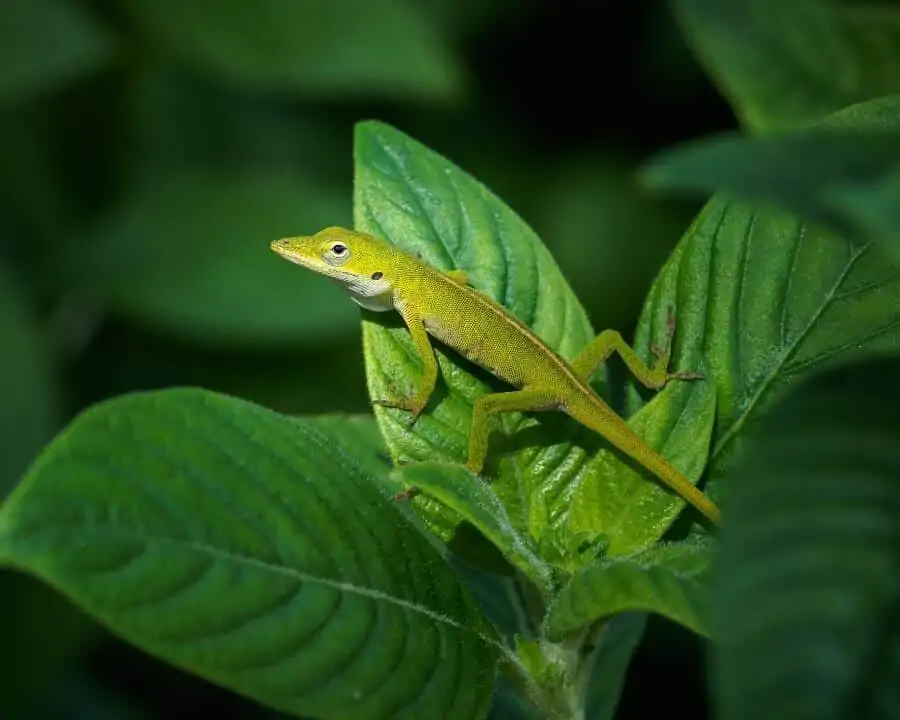
The green anole is native to states in the Southeast United States. They’re a frequent sight in backyards and parks. In most cases, you can spot these lizards climbing on tree branches and watching the world go by. Males will wave their bright pink dewlap around to signal females and establish their territory.
In captivity, the green anole is very easy-going. It doesn’t require a massive enclosure. A small vertically oriented tank is all they need.
That said, proper decorations are a must! These pet lizards prefer to live around dense vegetation for shelter. They also need some climbing branches for exercise and enrichment.
Ackies Monitor
Native to arid regions in Australia, the Ackies monitor is a revered species in the reptile world. These lizards belong to the same genus as the Komodo dragon. They even have a similar intimidating look. But, Ackies monitors are much more docile and easy-going.
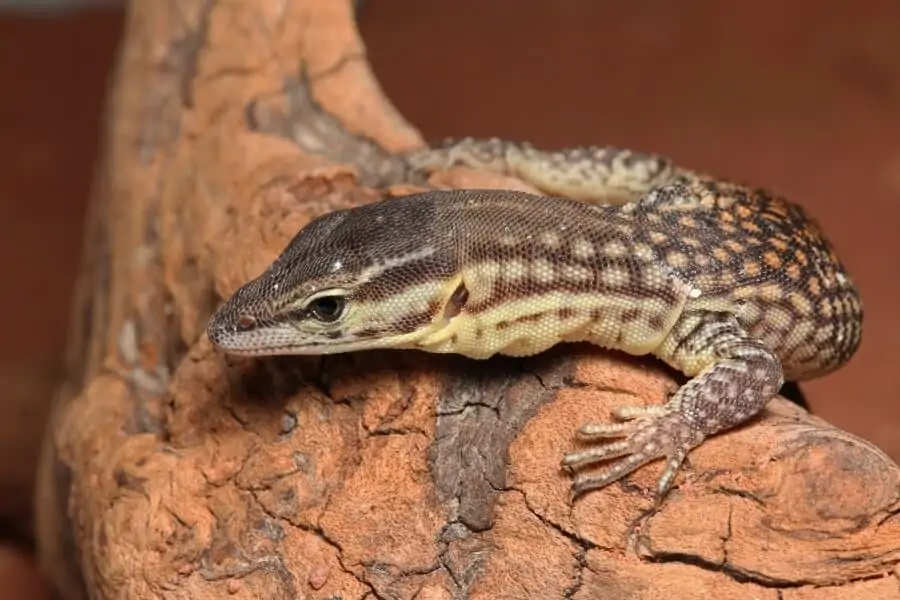
Once they get settled into a new home and get comfortable with humans, they are rather peaceful. Of course, poor husbandry and stress can lead to some aggression here and there. But a well-maintained environment will keep them happy for years to come.
Speaking of which, Ackies monitors are a long-lived species. They can also get pretty big, reaching lengths of up to 28 inches when mature. As a result, owning an Ackies monitor can be a big commitment.
They also have some unique needs you have to meet. These pet lizards enjoy burrowing and prefer to have a basking spot that’s as hot as 120 degrees Fahrenheit! Meeting those needs can be a challenge, but the extra work is worth it to raise these beauties!
Rankin’s Dragon
At first glance, it’s easy to mistake the Rankin’s dragon as a standard beardie. But upon closer inspection, you’ll notice finer details that make this species stand out from its more popular cousin.
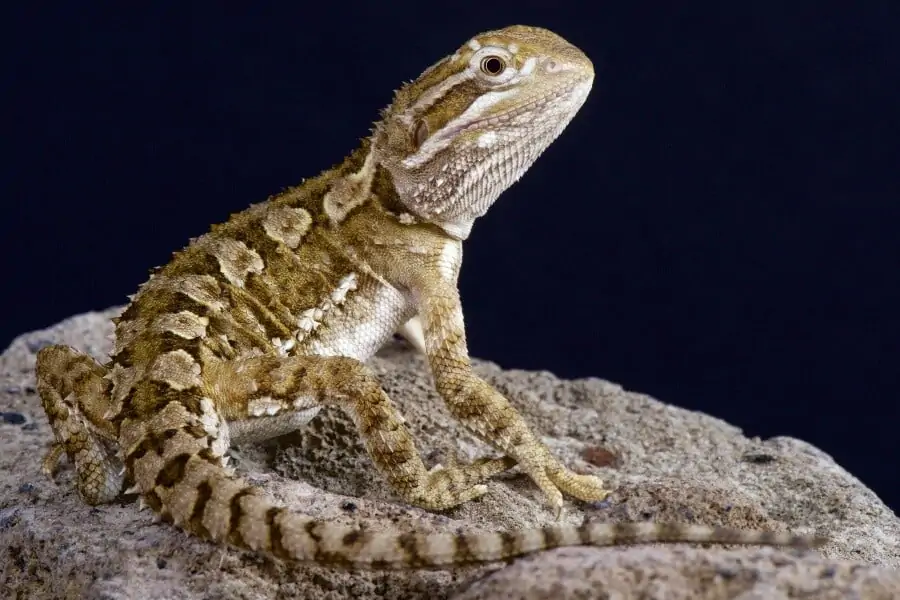
Rankin’s dragons are several inches smaller. Plus, they have a more subdued “beard.” These lizards are also available in a variety of morphs thanks to the breeding community.
Another notable trait of this species is its social nature. Unlike other types of pet lizards, Rankin’s dragons thrive in small colonies. Some fighting can occur with males. But females can get along just fine.
A well-decorated enclosure can also promote better behavior amongst a small group of lizards. These reptiles need strategically placed branches for climbing, rocks for basking, and plants for hiding. They also like to have several hiding boxes to get some peace and quiet.
Leopard Gecko
The leopard gecko is one of the most popular pet lizards in the trade (and one of the most popular types of pet geckos as well). They are readily available from most pet stores and usually come with an affordable price tag to boot!
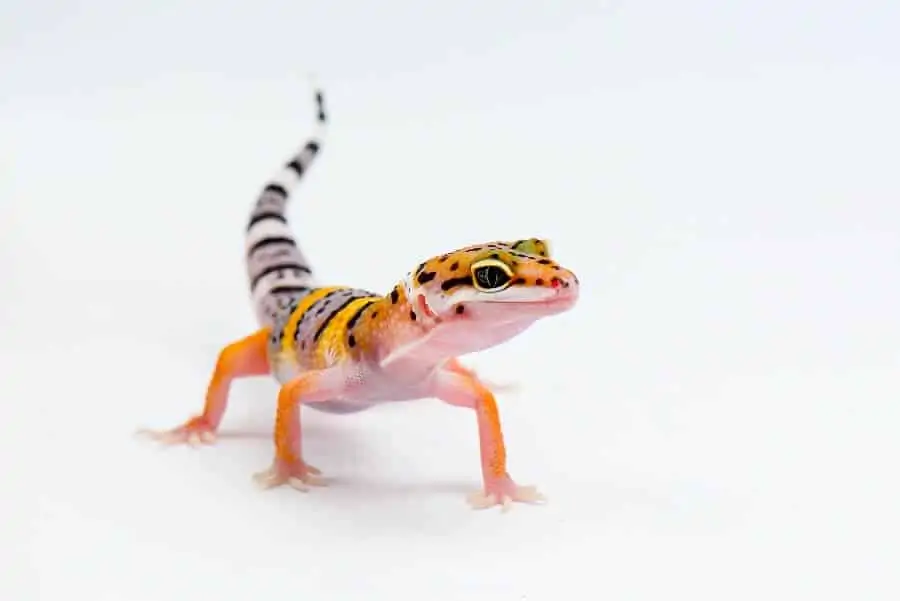
This lizard gets its name from the black and brown spots that cover its entire body. Against the yellow-tan base color, these spots create a beautiful pattern that’s reminiscent of the leopard feline.
Measuring roughly seven to ten inches long as adults, leopard geckos are manageable and easy to care for. Despite belonging to the gecko family, these lizards do not have the sticky toe pads these animals are known for.
Thus, they don’t require a ton of climbing surfaces. You don’t even have to worry about them climbing up the glass!
Most will spend their days resting inside a shelter or exploring their territory.
African Fat-Tailed Gecko
The African fat-tailed gecko is a type of lizard with a quirky name and an even quirkier appearance. As their common name would suggest, these lizards have bulbous tails!
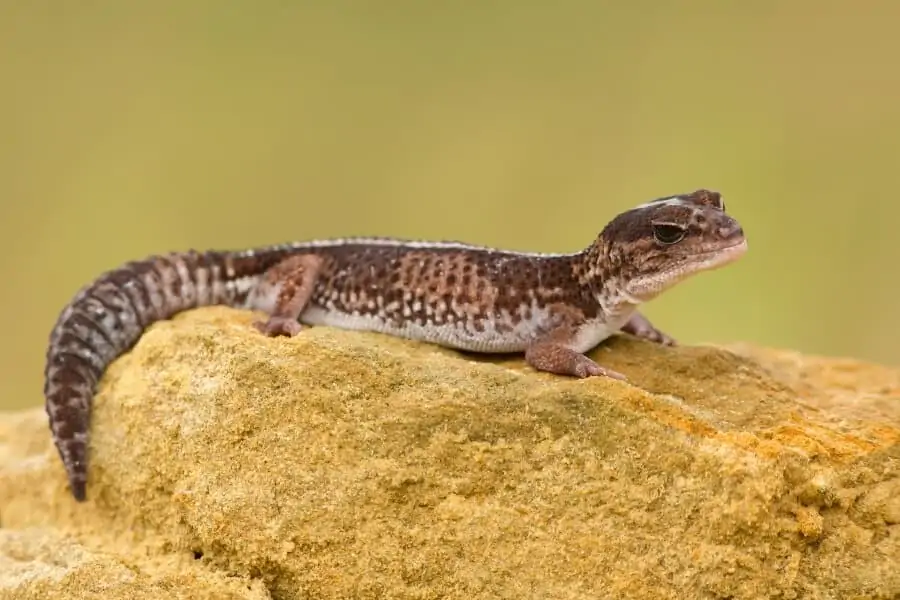
Many compare the look of the tail to that of a caterpillar. It’s bulbous in the middle and tapers down to a dull point. Pair that with the ridged skin and you have a tail that could easily get mistaken for grub!
The tail plays an important role in the lizard’s survival in the wild. It uses it to store energy in times of drought or famine.
Of course, captive lizards don’t have to worry about any of that. But, the fat tail still remains!
One cool thing about the tail is that you can often observe the reptile using it to hunt prey. They will wave the tail around to distract insects before going in for the kill!
Gargoyle Gecko
Here’s a strikingly beautiful species with a lot to offer in the looks department. The gargoyle gecko is an interesting pet lizard that comes in a wide range of color patterns. It’s polymorphic, so there’s no “standard” coloration in existence.
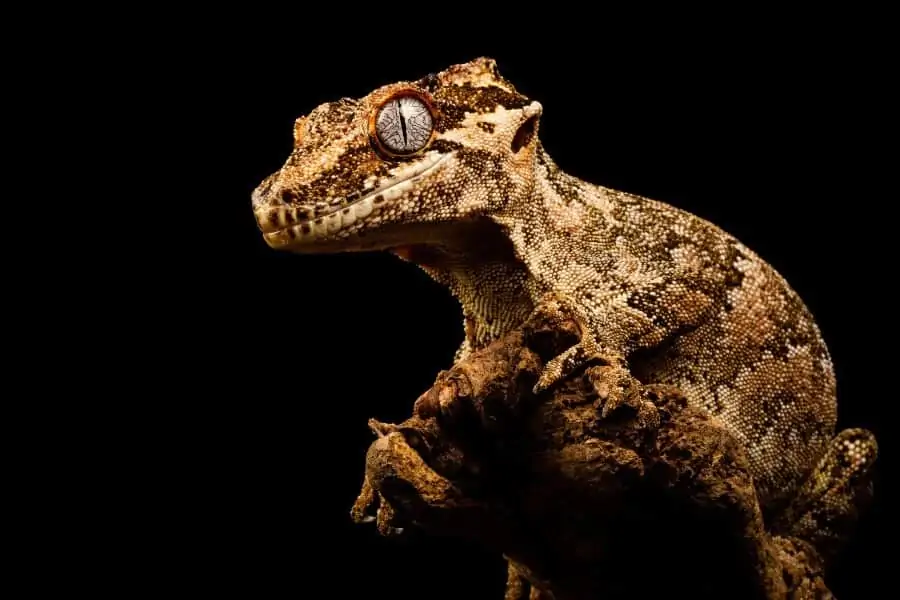
You might see specimens covered in muted tones of gray, vibrant shades of red, or natural hues of brown. Thanks to their polymorphic nature, gargoyle geckos are a favorite among breeders. Breeders will use selective breeding techniques to create babies with the most vivid coloration popular.
While they can take on many colors, there is one feature all gargoyle geckos have. They all sport a series of cranial bumps on the head. The bumps mimic horns, which is why they have their common name.
Even with their sometimes scary look, gargoyle geckos are very peaceful. They can exhibit some territorial behavior and aggression towards others. But with humans, they usually do just fine.
Uromastyx
If you want a rare and cool pet lizard to call your own, try the uromastyx on for size. This species is still relatively new to the pet trade. They’re highly sought-after by collectors, so they can be tough to find.
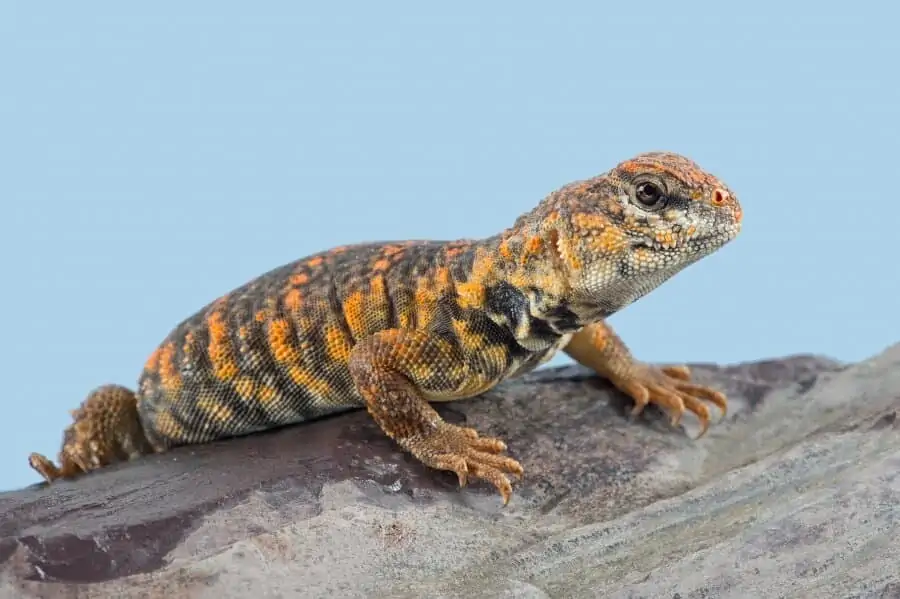
But if you’re lucky enough to get your hands on one, these lizards are some of the most interesting to care for. Unlike most types of lizards, these critters do not like tropical environments.
Uromastyx come from Northern Africa and the Middle East. As a result, they prefer dry and arid climates. They will not tolerate standard reptile setups filled with humid aid and moisture-retaining substrates.
Instead, they need sand, rocks, and plenty of heat! In the basking area, they like temperatures to be as high as 120 degrees Fahrenheit. Even on the “cool” side, warmer temperatures are a must.
Pygmy Chameleon
Check out this tiny little lizard! The pygmy chameleon is very tiny compared to other breeds. As a full-grown adult, it usually only reaches lengths of three to three and a half inches!
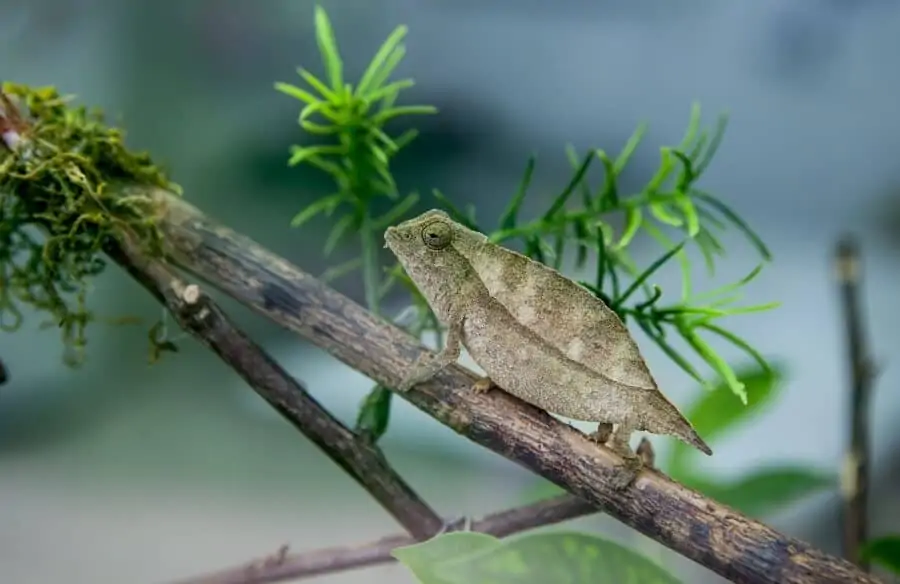
That’s not all. These lizards have a cool appearance, too. The body is taller than other chameleons. They also have significantly shorter tails. This species spends most of its time on the forest floor, so they don’t have a prehensile tail.
The color of the pygmy chameleon is muted. You might see shades of olive green, gray, and brown. Pair that with the unique shape of the body and these lizards look like walking leaves.
Thanks to their small size, they don’t need huge environments. You can keep one in something as small as a five-gallon tank.
Panther Chameleon
Naturally found in the lowlands of Madagascar, the panther chameleon is a favorite among reptile collectors. The lizard can take on a wide range of colors, resulting in some beautiful color morphs.
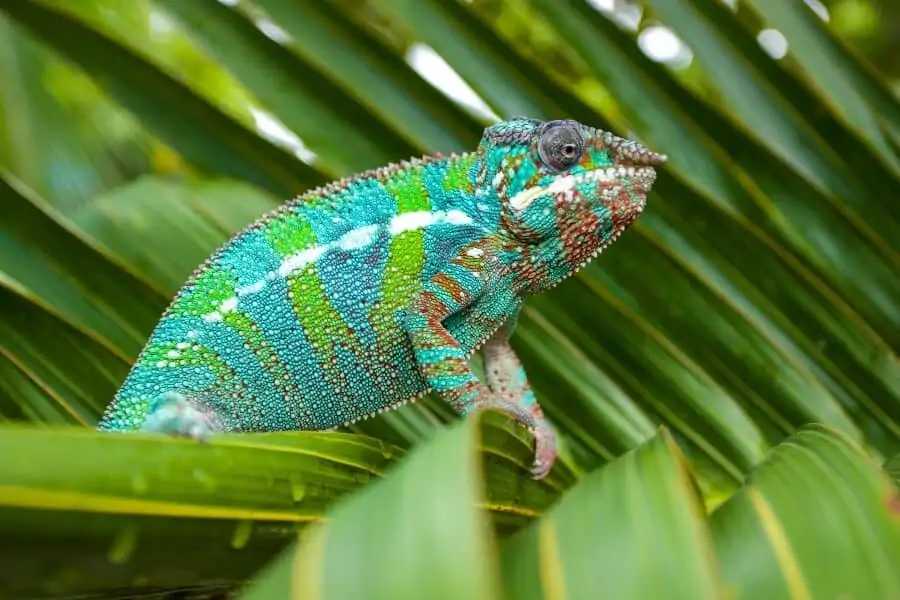
Like most chameleon species, the panther doesn’t like handling. It would prefer to stay in the safety of its habitat as much as possible.
This species has a unique history in the pet trade. When first brought over from Madagascar in the 1980s, not much was known about them. As a result, many captive lizards didn’t make it too long in captivity.
Luckily, a lot has changed in the last few decades. We know a lot more about the needs of this pet lizard, which has resulted in improved life expectancy. With proper care, a panther chameleon can live between three and seven years in captivity.
Frilled Dragon
Don’t let their sinister appearance fool you. Frilled dragons are very personable and can be a joy to care for! Thanks to Hollywood, the frilled dragon has been thrust into the limelight. As a result, they’re a hot commodity within the pet trade.
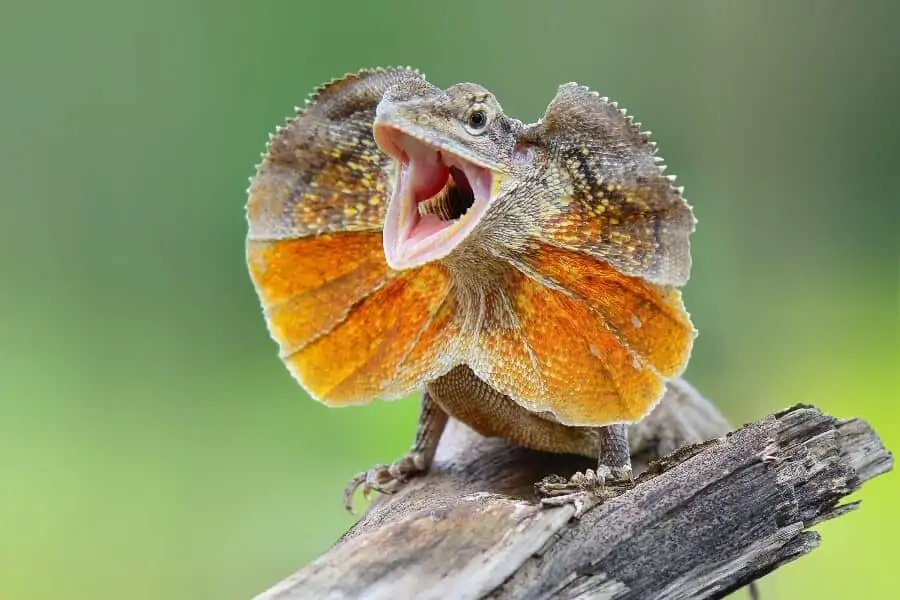
This lizard gets its name from a flap of skin that surrounds the head. When the reptile is comfortable and relaxed, the frill sits on its body. But the moment it gets stressed or feels threatened, the lizard will pop the frill up to look bigger and more threatening.
There’s no denying that this defense trick works well. Seeing the frill pop up can be downright sinister! Thanks to the brighter coloration on the frill, it’s a sight that you can’t miss!
Frilled dragons can become personable with humans. But, it often takes time to build that trust. Once you get there, these cool pet lizards are more than happy to leap into your hand to show off.
Green Basilisk
The green basilisk is native to lowlands in South and Central America. They usually stick to environments around water. Sometimes, people refer to these lizards as “Jesus lizards.”
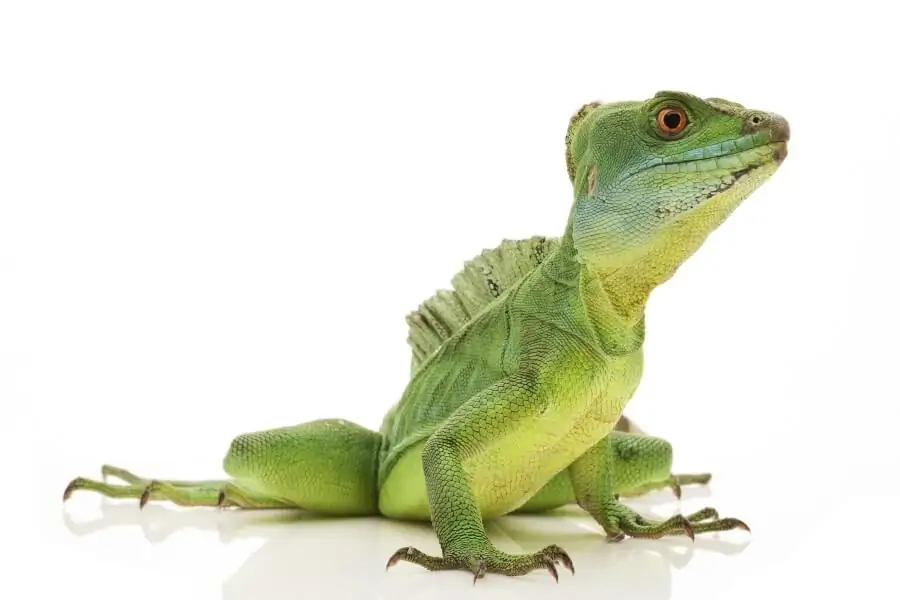
Why? Well, they can run on the surface of the water for short periods! It’s a unique getaway trick that they use to flee from predators.
In captivity, the lizard won’t have to worry about harm from predators. Luckily, they don’t need to have access to large bodies of water. They can do just fine in a large, well-decorated vivarium.
Green basilisks are truly a thing of beauty. Covered in shades of bright green, the lizard looks similar to many iguanas and other reptiles. However, they’re also sporting a series of signature dorsal crests.
The crests start at the head and stretch down to the tail.
Veiled Chameleon
This instantly recognizable lizard species is a staple in the pet trade. They are gorgeous reptiles with a penchant for changing appearances.
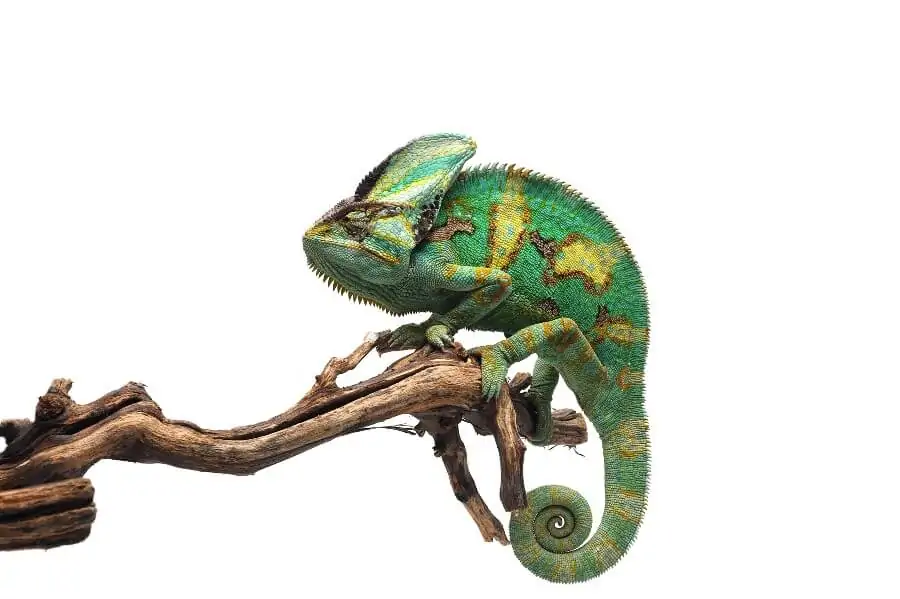
The standard color for veiled chameleons is green. They often have bands of yellow and brown as well. However, the reptile is capable of changing its body color.
You can observe this behavior in captivity. Oftentimes, they do it to blend in with their surroundings. However, you might also see it when they’re trying to communicate with others. Females may also flash some bright colors around breeding time.
Beyond their changing skin color, veiled chameleons also have a signature hump. Called the casque, the hump helps to catch and divert water to the mouth.
Contrary to popular belief, veiled chameleons aren’t too big on handling. They are best observed through the glass of the enclosure.
Crested Gecko
With a lifespan of up to 20 years in captivity, the crested gecko is a type of pet lizard that requires a lot of commitment. Clearly, that’s not a problem for most reptile lovers. This species is one of the most popular in the trade and can be found in captive habitats all over the world!
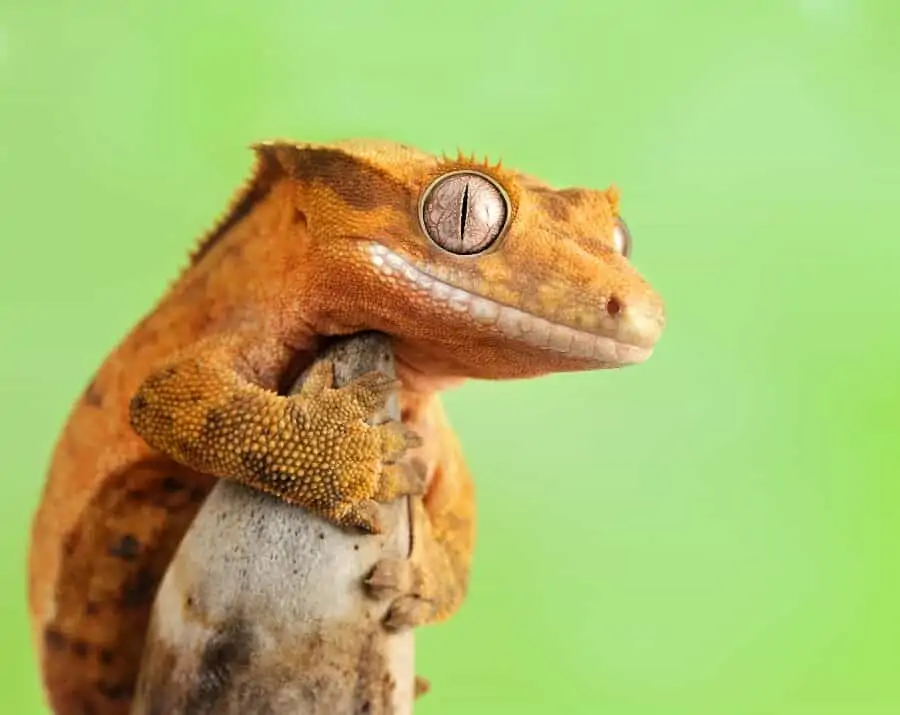
For a while, many thought that the crested gecko was extinct in the wild. However, wild populations are thriving in New Caledonia. As for the pet trade, almost all specimens are a product of breeding.
Thanks to the hard work of breeders, you have a ton of different color morphs to choose from. The most common features shades of brown and cream. However, red, white, orange lizards are prevalent, too.
The thing that sets crested geckos apart from others is the fringed crest that lines the head and back. This spiky physical feature can vary in size from lizard to lizard. But, all specimens have it.
Savannah Monitor
If you’re ready to commit to a larger-than-life pet lizard, the savannah monitor is for you! As a mature adult, these lizards can measure anywhere between three and four feet long! They are much larger than most of the common species you see in the trade.
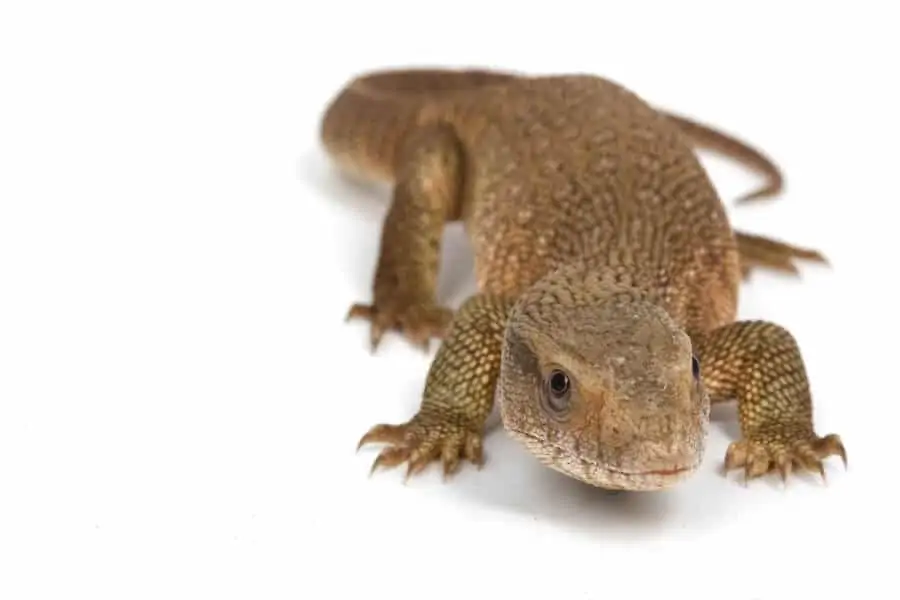
Unfortunately, their large size does make them a rare commodity. They have some distinct care guidelines that you must meet. Otherwise, the lizard will not do well in captivity.
Savannah monitors aren’t very active. Throughout the day, they will usually bask in the sun or lounge around. Sometimes, you might see them attempting to burrow in the substrate.
In terms of behavior, savannah monitors can be hit or miss. With proper care and regular handling, they can become docile and easy-going. But, those that aren’t used to human interaction are prone to biting and scratching.
African Fire Skink
Friendly and easy to care for, African fire skinks are excellent for those without a ton of reptile experience. Despite their easy-going nature, these pet lizards are anything but boring. They are gorgeous creatures that you’ll want to show off!
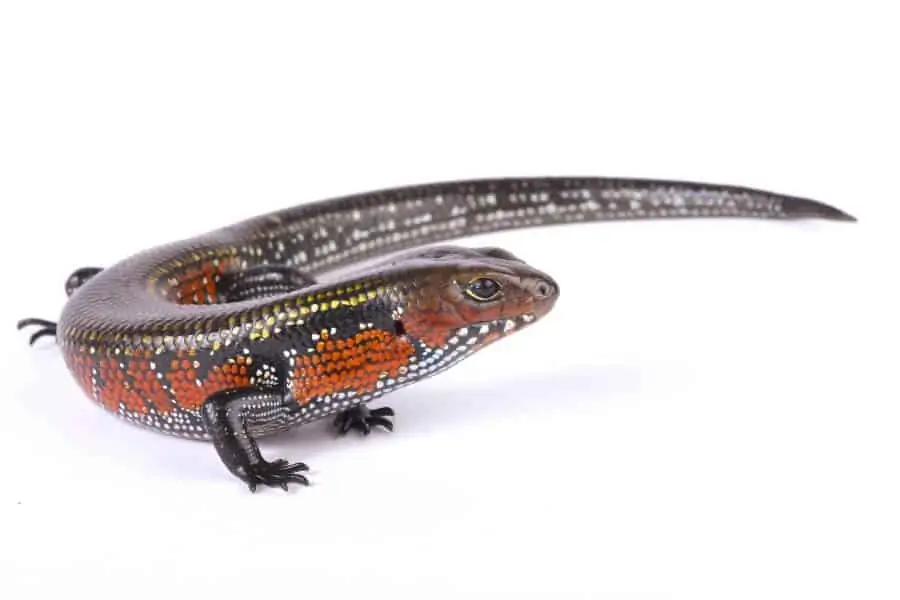
Like other skink species, the fire skink has a long and stocky body. The legs are comparatively small, but they’re still quite strong.
In terms of color, you might see lizards with shades of black, white, or silver. Of course, they also have bright red scales. It’s how they get their namesake!
The bright scales stand out among the more muted colors, creating a beautiful appearance.
Overall, African fire skinks are undemanding in captivity. They have simple dietary requirements and aren’t super picky about food. One thing they do need, however, is natural decor. Without things like logs, driftwood, hide boxes, and rocks, the reptile can start to feel unsafe.
Gold Dust Day Gecko
Gold dust day geckos aren’t the easiest reptiles to care for. But if you know what you’re doing, raising them can be a rewarding experience.
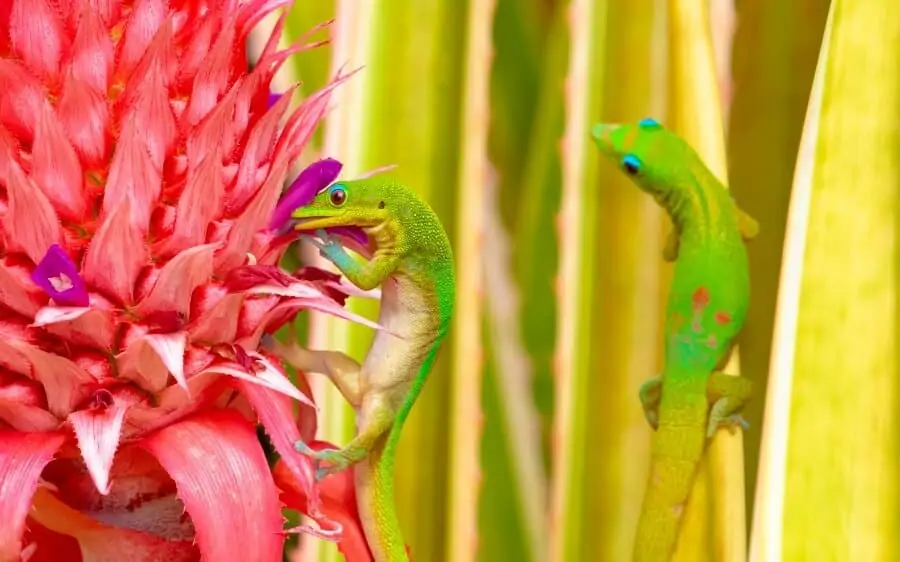
These pet lizards are real beauties. The primary color is bright green. However, they have textured skin with fine dots of yellow. Some lizards may also have neon blue on their feet and eyes and subtle red accents on the snout. These colors combine to create a truly beautiful look.
Measuring only about four to six inches long, you don’t need a large enclosure. But, that extra space may help to meet their environmental needs. These lizards require a well-decorated tank with all the bells and whistles.
This means adding plants, climbing branches, and other items to replicate their natural habitat.
Long-Tailed Lizard
The most defining trait of the long-tailed lizard is right in its name. It has an abnormally long tail that can sometimes look out of place on its body.
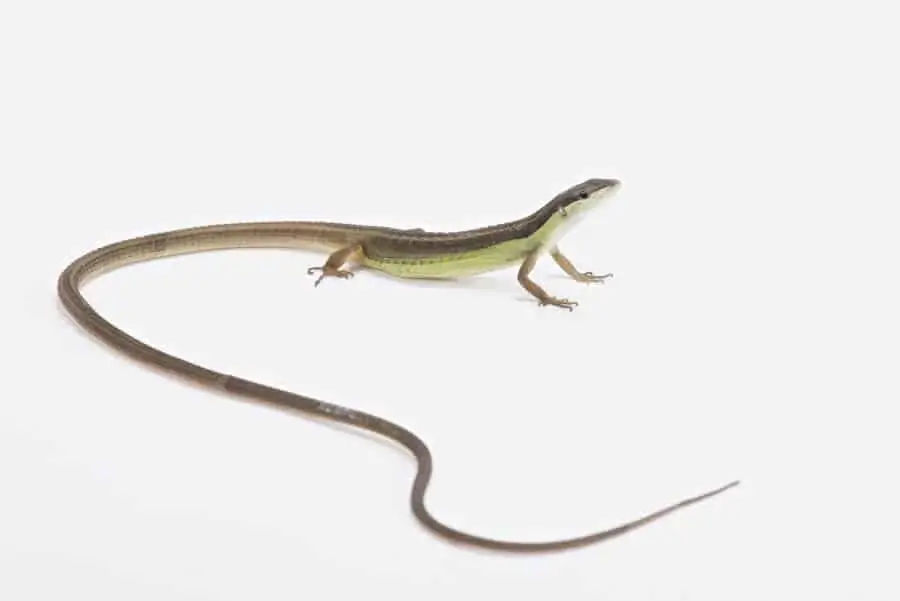
As adults, these popular lizards get to be about 10 to 12 inches long. However, about eight inches of that length is dedicated to the tail alone! It whips behind them as they scurry along the bottom of the enclosure.
Speaking of which, this is a fast lizard species. They are very quick on their feet. As a result, they can be a bit tricky to handle. You have to be extra careful to ensure that the lizard doesn’t leap out of your hands and scurry off to hide somewhere.
You must also exercise caution with kids. When the lizard gets scared, it will thrash its tail around for protection.
Chinese Water Dragon
The Chinese water dragon is often mistaken for green iguanas. But upon closer inspection, you’ll start to notice some standout physical features that make this type of lizard unique in its own right.
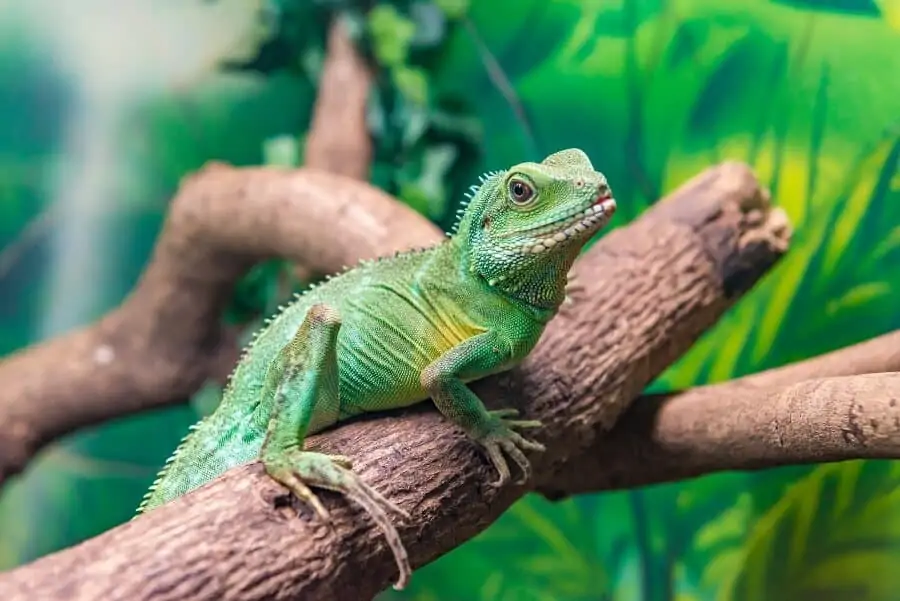
The first is the tail. The tail takes up about 70 percent of the reptile’s length. As adults, males are usually around three feet long, so the tail is quite long compared to the rest of the body.
The color of the chinese water dragon is beautiful, too. As adults, they take on shades of bright green to vibrant mint. Interestingly enough, they develop this color over several years. Juveniles are usually more muted in tone, taking on a duller brown color.
Another cool feature of the chinese water dragon is its third eye! Called the parietal eye, it’s in the center of the two other eyes and helps to measure light changes.
Sailfin Dragon
Feast your eyes on this prehistoric beauty! Sailfin dragons are one of the more distinct pet lizards in the trade.
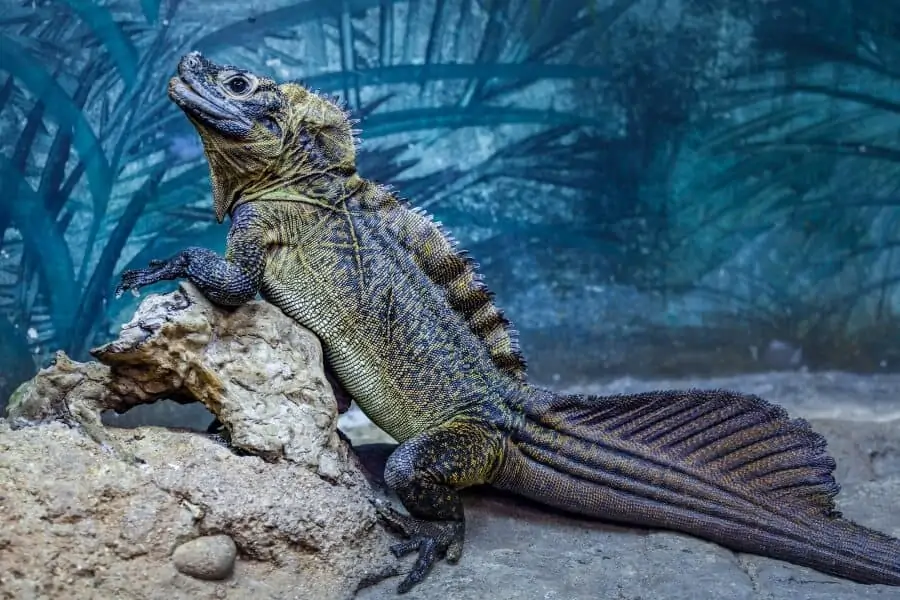
As you can guess from their name, these reptiles have long fins that stretch along the back. Typically, the fin starts on the head or just behind the neck. On the tail, the fin is expansive and creates a fanned look that’s undeniably beautiful!
These aren’t small lizards by any means. As adults, most will measure around three feet long. However, it’s not uncommon to see males reaching four feet or more in length. This can even occur in captivity!
Caring for a sailfin dragon is no easy task. Thanks to their massive size and delicate fins, they need a large enclosure. But if you can supply that, it’s smooth sailing moving forward.
Green Iguana
Here’s a popular pet lizard species that you’ve likely seen before. Green iguanas are native to tropical and subtropical regions throughout North and South America. They are very widespread, which has led to their impressive availability in the trade.
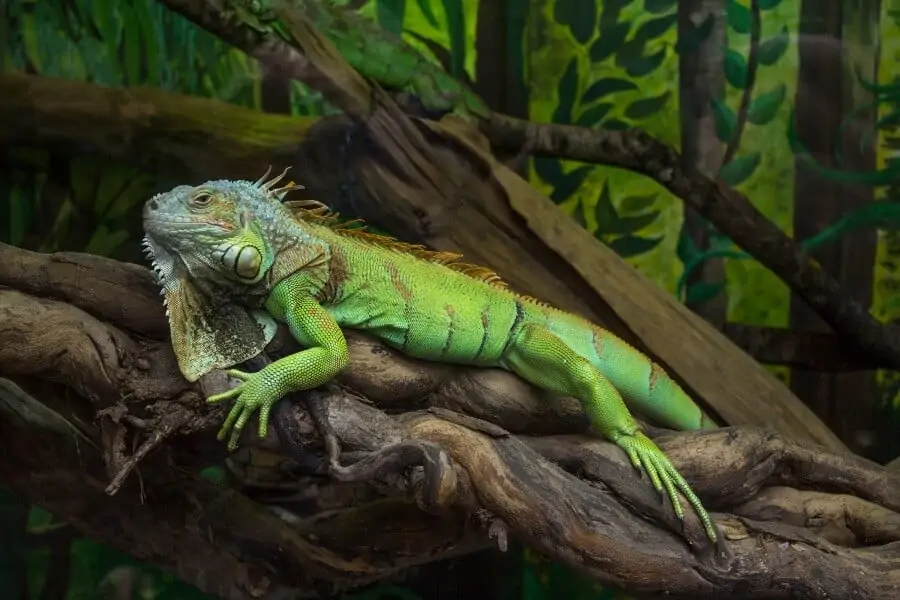
Many believe that the green iguana is one of the best and most commonly available pet lizards in the world. In the United States alone, approximately one million are imported every year!
Green iguanas can get very big. Adults can easily reach lengths of six to seven feet. As a result, they require massive enclosures. While many start them off in standard vivariums or reptile terrariums, they quickly outgrow those spaces.
By the time they reach adulthood, they require larger habitats that are at least 12 feet long by six feet wide and six feet tall.
Blue-Tongue Skink
The blue-tongue skink isn’t the most colorful type of lizard species in the world. But when they open their mouths, they display a beautiful pop of color.
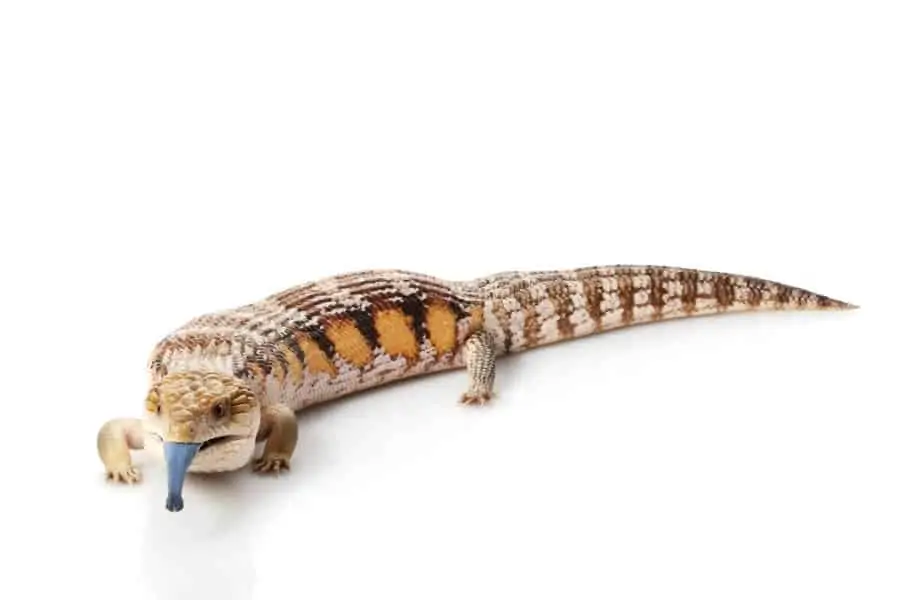
The body of the lizard is usually light brown. However, there is some variation between the subspecies. You might see shades of orange, red, or gray. Whatever the case may be, all lizards have a vibrant blue tongue and mouth!
These reptiles have a very interesting body shape, too. They are large and heavy. Compared to their build, the legs are quite small. Pair that with the scaly skin and these lizards are often mistaken for snakes when buried.
Caiman Lizard
Native to the Amazon River Basin, the caiman lizard is a species that requires a specialized environment. You cannot keep these reptiles in basic vivariums or standard enclosures. They need to be able to submerge themselves in water at all times.
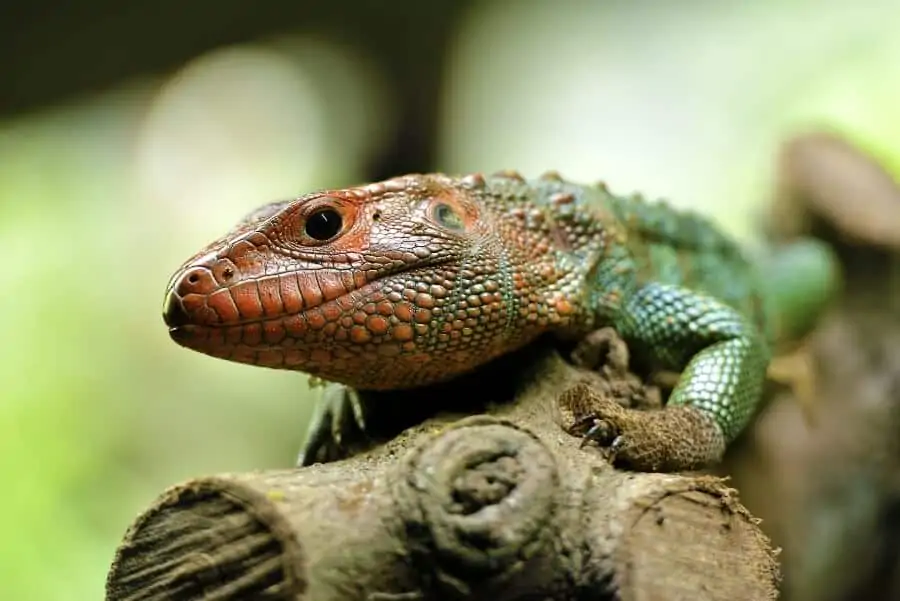
Owners often have to build specialty habitats to cater to this need. It seems like overkill, but this pet lizard needs access to water to stay happy and healthy.
Another unique thing about the lizard is its diet. In the wild, it feeds on aquatic snails most of the time. They have powerful neck and jaw muscles that can make quick work out of a hard shell.
Due to their unique care requirements, caiman lizards can be a challenge for novice reptile enthusiasts.
Argentine Giant Tegu
The Argentine giant tegu is an intimidating pet lizard that’s not for the faint of heart. As their name would suggest, they are large creatures that require a ton of space.
As an adult, the Argentine giant tegu can reach lengths of about five feet (which puts them on the larger end of tegu lizards). They are very small as juveniles. But the lizards grow up fast and quickly outgrow standard enclosures.
Argentine giant tegus also have a reputation for being a bit on the aggressive side. They will fight with one another if kept in the same habitat. They may even show aggression towards humans.
But like all reptiles, proper handling and care can bring out their docile side.
Honorable Mention – Mediterranean House Gecko
The Mediterranean House Gecko also known as the Turkish gecko gets an honorable mention in our list as its easy to look after and has a lot of unique features. A small, nocturnal lizard that can adapt to a variety of environments. Its diet mainly consists of small insects, making feeding simple. Also known for its impressive vocalisations and its ability to climb smooth surfaces, which makes watching them a lot more interesting.
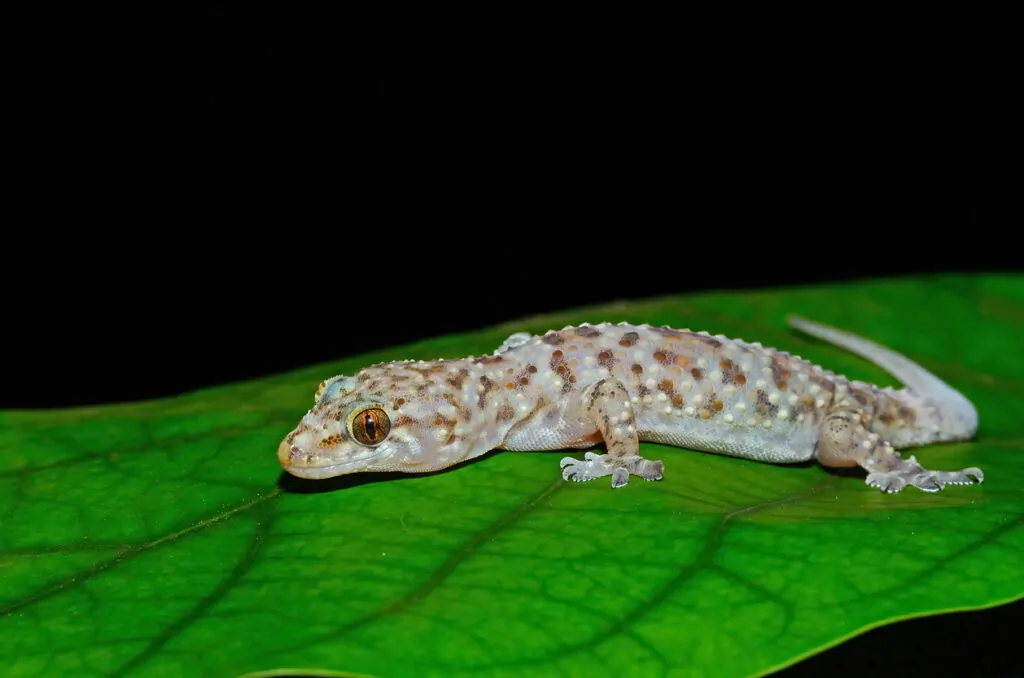
Its hardy nature and minimal space requirements make it an excellent choice for beginners who might not be ready for some of the harder reptiles to care for. This gecko’s low maintenance and good nature, along with its interesting behaviors, make it another good choice for those looking into their first pet reptile.
Easiest Pet Lizard for Beginners
We have chosen the Leopard Gecko as the easiest pet reptile to own, making it an ideal choice for first-time reptile owners for the following reasons:
- Low Maintenance: Leopard geckos are relatively low maintenance compared to other lizards. They don’t require a large enclosure, and their dietary needs are straightforward.
- Docile Nature: They are known for their docile and easy-going nature, making them less daunting for new owners who might not be used to handling reptiles.
- Health: They are generally robust and have fewer health issues, which is ideal for someone who might not be familiar with more complex care requirements.
Most Enjoyable Beginner Friendly Lizard
The obvious standout for us for the most popular beginner-friendly lizard is the Bearded Dragon for the following reasons:
- Temperament: Bearded dragons have a friendly and approachable temperament. They are known for their willingness to interact with humans, which can be rewarding for owners looking for a more engaging pet experience.
- Activity Level: They are more active during the day (diurnal), which aligns well with human activity patterns, making it easier for interaction.
- Diet and Care: While their diet is a bit more varied than that of the leopard gecko, it offers a great opportunity to bond through feeding a range of foods like vegetables, fruits, and insects.
Time To Make Your Pick!
While picking between the best types of pet lizards can seem difficult at first, the process should be a whole lot easier if you stick to the recommendations on this list. Our pick for best would be a leopard gecko for these easiest Lizard to own, with Bearded dragon being our overall favourite.
We’ve had great experiences with the species we included, and think you will too!

